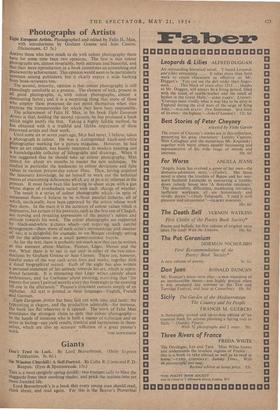AMONG those who have much to do with colour photography
there have ,for some time been two opinions. The first is that colour Photographs are, almost invariably, both accurate and beautiful, and that their mere reproduction in a book constitutes an astonishing and Praiseworthy achievement. This opinion would seem to be particularly common among publishers, but it clearly enjoys a wide backing from book-reviewers too. . The second, minority, opinion is that colour photography is still exceedingly unreliable as a process. The element of luck, present in all good photographs, is, with colour photographs, almost a dominating factor; and it is a surprising thing that more of those who employ these processes do not pistol themselves when they examine the transparencies for which they have been responsible. The achievement of Felix H. Man, in his book Eight European 'Artists is that, holding the second opinion, he has produced a book which might justify the first. Taking a highly fallible method, he has obtained with it a truthful and lifelike impression of these renowned artists and their work.
Until some six or seven years ago,•Man had never, I believe, taken a photograph in colour. He was a distinguished black-and-white Photographer working for a picture magazine. However, he had been an art student, was keenly interested in modern painting and a knowledgeable collector of lithographs and drawings. When it Was suggested that he should take up colour photography, Man retired for about six months to master the new technique. He ,studied in particular the tendencies to colour deviations and false "Values in various present-day colour films. Then, having acquired the necessary knowledge, he set himself to work out the technical means of overcoming deficiencies which arc at present inherent in the process. It must have been like learning to shoot snipe with a gun whose degree of crookedness varied with each change of weather.
The result is a series of colour photographs which—in spite of occasional flaws--.I believe to be without parallel hitherto, all of which, incidentally, have been approved by the artists whose work they show. In the main it is the accuracy of colour values which is impressive, but certain of his portraits, such as the first one of Chagall, are moving and revealing expressions of the painter's nature and attitude towards his work., The colour photographs are supported by black-and-white p:cturcs which—not rcqu.r.ng such careful arrangement—show more of each artist's surroundings and manner of life; it is delightful, for example, to sec Braque smilingly setting off for the afternoon on a small power-assisted bicycle.
As for the text, there is probably not much new that can be written at this moment about Matisse, Picasso, Leger, Moore and the rest. What there is to say is not said in either of the two intro- ductions by Graham Greene or Jean Cassou. There are, however, careful notes of the way each artist lives and works, together with a dated biographical record. Each of the eight has also written a personal statement of his attitude towards his art, which is repro- duced facsimile. It is interesting that Leger writes entirely about architecture, and Le Corbusier about painting, recording that for twenty-five years 1 painted secretly every day from eight in the morning till one in the afternoon." Picasso's statement consists simply of an alphabet. All text is printed in three languages— English, French and German.


































 Previous page
Previous page